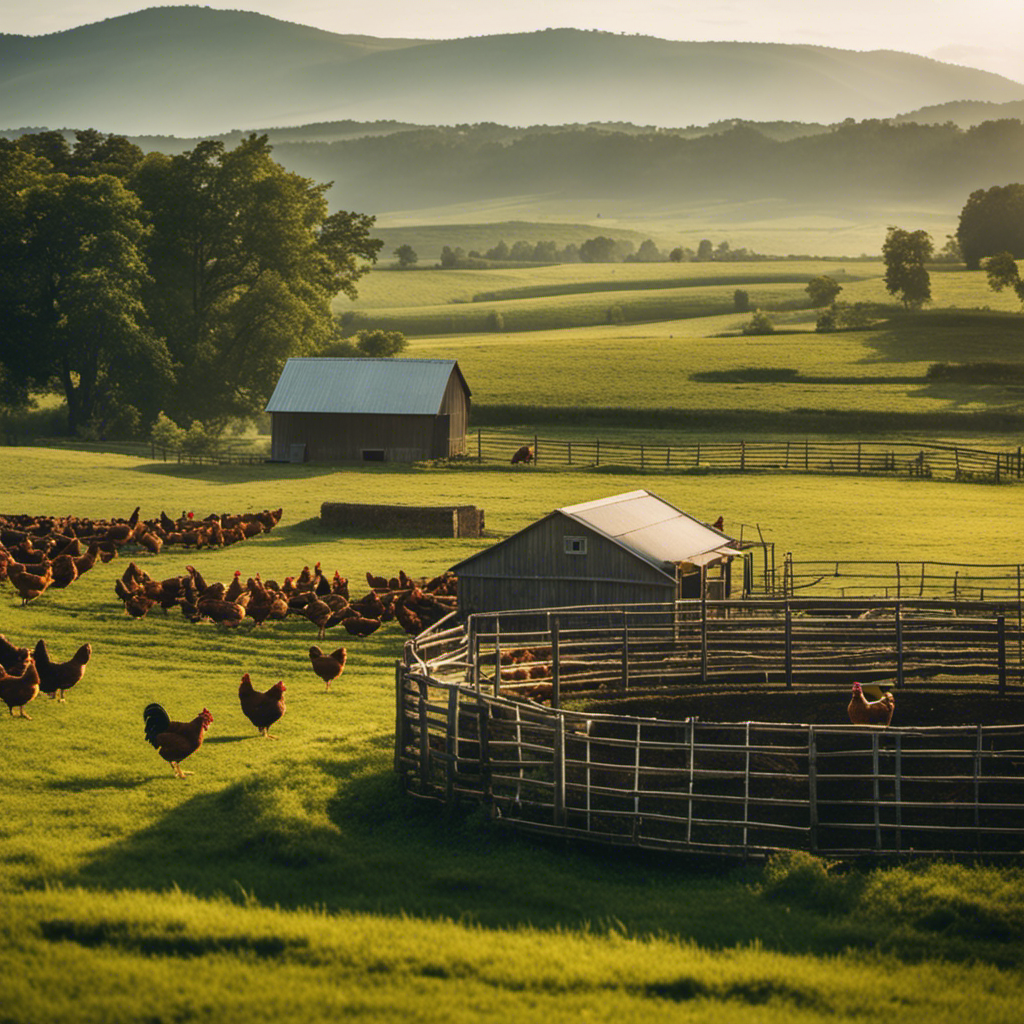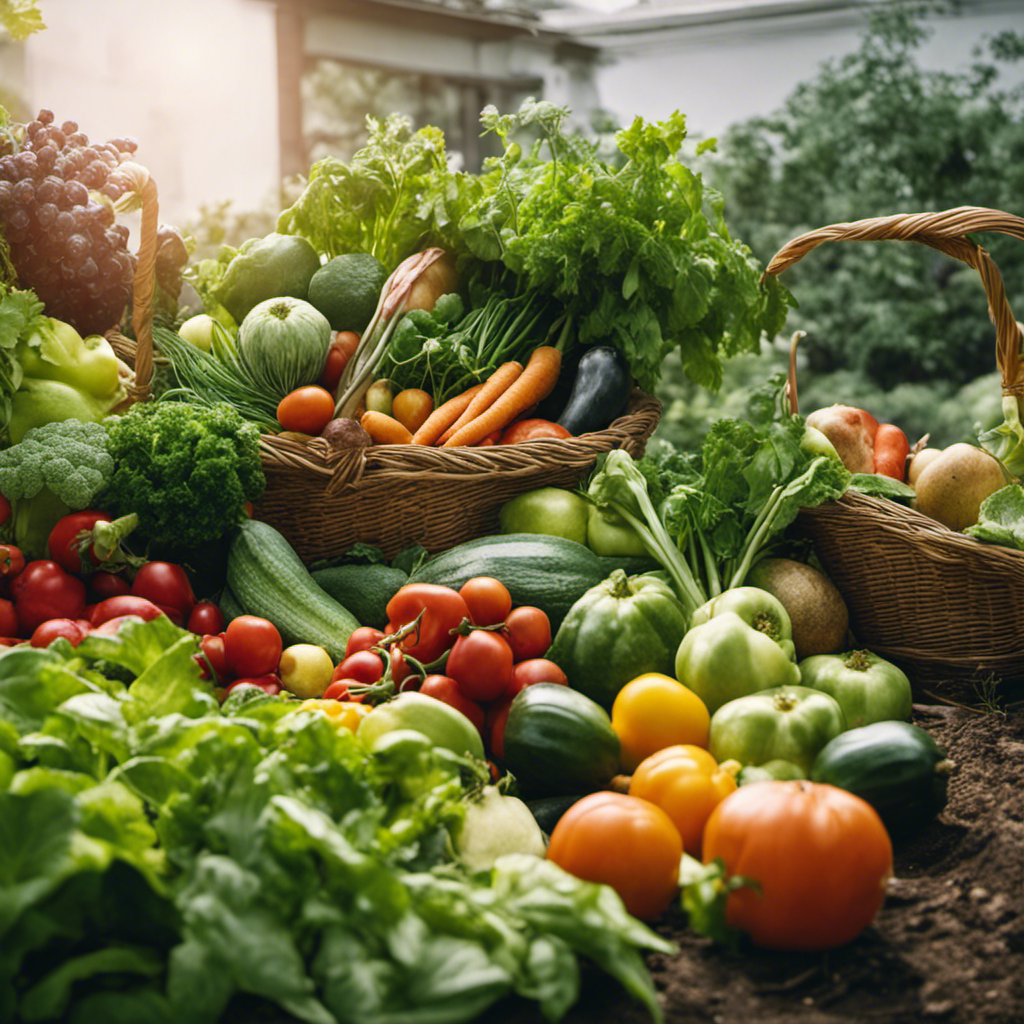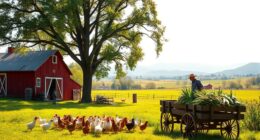Are you ready to enhance your abilities in raising livestock? We offer everything required with our expert guidance for attaining success.
From chicken farming to pasture management, we’ve gathered the most crucial advice to help you thrive in this industry.
Get ready to revolutionize your housing, nutrition, breeding, and more. With our experienced guidance, you’ll be well-equipped to tackle any challenge that comes your way.
So, let’s dive in and unlock the secrets to successful livestock raising!
Key Takeaways
- Providing a comfortable and safe environment for livestock is crucial for their well-being and overall health.
- Selective breeding for desired traits, genetic diversity, and disease resistance is essential for the long-term sustainability of livestock farming practices.
- Finding the right balance in flock/herd size and stocking density is important to prevent overcrowding, stress, and disease outbreaks.
- Proper pasture rotation and grazing management techniques, such as rotational grazing, can maximize forage utilization, maintain pasture health, and control parasite infestations.
Proper Housing and Infrastructure
We believe that proper housing and infrastructure are essential for ensuring the well-being and productivity of our livestock. When it comes to housing design, we prioritize creating a comfortable and safe environment for our animals. This includes providing adequate space for each animal, as well as incorporating features that promote their natural behaviors and prevent injuries.
Ventilation systems are also crucial in maintaining good air quality inside the barns, preventing the buildup of harmful gases and controlling temperature and humidity levels. By investing in well-designed housing and ventilation systems, we can minimize stress and disease among our livestock, leading to healthier and more productive animals.
With these foundations in place, we can now move on to discussing the importance of effective nutrition and feeding in our livestock management practices.
Effective Nutrition and Feeding
When it comes to effective nutrition and feeding for livestock, we’ve found that a balanced feed is crucial for optimal growth and development. By providing the right combination of nutrients, vitamins, and minerals, we ensure that our animals receive all the necessary elements to thrive.
Additionally, understanding their specific nutrient requirements and implementing feeding strategies that promote efficiency are key factors in maintaining their health and maximizing productivity.
Balanced Feed for Growth
Our livestock thrives on a balanced feed, ensuring optimal growth and nutrition. When it comes to feeding our animals, we follow a carefully crafted balanced feed formulation that meets their specific dietary needs. Here are three key points to consider:
-
Protein requirements:
Protein is crucial for the growth and development of our livestock. We ensure that our feed contains the right amount of protein to meet their needs. This helps in building strong muscles, promoting healthy weight gain, and supporting overall health. -
Nutrient balance:
A balanced feed formulation is essential to provide the right balance of vitamins, minerals, and other nutrients. This helps in maintaining good health, boosting immunity, and preventing nutrient deficiencies. -
Feed quality:
We prioritize the quality of our feed to ensure that it’s free from contaminants and provides the necessary nutrients. We source high-quality ingredients and follow strict quality control measures to ensure that our livestock receives the best possible feed.
Nutrient Requirements for Health
To ensure the health of our livestock, it’s important to understand the nutrient requirements for effective nutrition and feeding. Nutrient deficiencies can have detrimental effects on the overall well-being and productivity of our animals. Therefore, it’s crucial to provide a balanced diet that fulfills all their nutritional needs.
Livestock require a variety of essential nutrients, including proteins, carbohydrates, fats, vitamins, and minerals. These nutrients play a vital role in growth, reproduction, and the overall immune system of the animals. However, sometimes the diet alone may not be sufficient to meet all these requirements. In such cases, dietary supplementation becomes necessary to bridge the gap and prevent nutrient deficiencies.
Dietary supplementation can be in the form of specialized feeds or additives that provide the necessary nutrients. It’s important to consult with a veterinarian or animal nutritionist to determine the specific requirements of our livestock and to choose the appropriate supplements. Regular monitoring and evaluation of the animals‘ health and performance will help identify any potential nutrient deficiencies and allow for timely adjustments in their diet.
Feeding Strategies for Efficiency
As we focus on feeding strategies for efficiency, it’s essential to consider the role of timing in providing our livestock with the right nutrients at the right time. Proper feeding schedules are crucial for maximizing feed conversion efficiency and ensuring optimal growth and health of our animals.
Here are three key points to keep in mind:
-
Consistency: Establishing regular feeding times helps create a routine for our livestock, allowing them to anticipate and prepare for meals. This consistency promotes better digestion and nutrient absorption.
-
Nutrient timing: Providing the right nutrients at specific times can enhance feed conversion efficiency. For example, offering higher energy feeds during periods of increased activity or growth can support optimal performance.
-
Adjusting for age and production stage: Different livestock species and production stages have varying nutritional requirements. It’s essential to adapt feeding strategies accordingly, ensuring that each animal receives the appropriate nutrients for its specific needs.
Breeding and Genetics
When it comes to breeding and genetics in livestock, selecting ideal traits is essential for achieving successful outcomes. By carefully choosing traits such as growth rate, disease resistance, and temperament, we can improve the overall health and productivity of our animals.
Additionally, maintaining genetic diversity within our herds or flocks is crucial to prevent inbreeding and maintain a robust gene pool. Breeding for healthier livestock not only ensures their well-being but also contributes to the long-term sustainability of our farming practices.
Selecting Ideal Traits
We are currently discussing selecting ideal traits to improve the genetic composition of our livestock. When it comes to breeding and genetics, selecting the right traits is crucial for the overall success of our livestock.
Here are three key considerations for selecting ideal traits:
-
Choosing the right breeds: It’s essential to carefully select the breeds that possess the desired traits for our specific goals. Whether we’re looking for high milk production in dairy cattle or fast growth in meat poultry, selecting the ideal breeds is the first step towards genetic improvement.
-
Utilizing genetic selection techniques: Genetic selection techniques, such as pedigree analysis and performance testing, allow us to identify animals with superior traits and incorporate them into our breeding program. By using these techniques, we can ensure that the genetic composition of our livestock continues to improve over time.
-
Focusing on functional traits: While productivity traits are important, we must also consider functional traits such as disease resistance, adaptability, and longevity. By selecting for these traits, we can enhance the overall health and resilience of our livestock.
Considering the importance of selecting ideal traits, it’s also crucial to recognize the significance of genetic diversity in our livestock populations.
Genetic Diversity Importance
Maintaining genetic diversity is of utmost importance in our livestock populations to ensure the long-term health and adaptability of our animals. Conservation efforts and biodiversity preservation play a crucial role in safeguarding the genetic variation within our livestock species. By preserving diverse gene pools, we can enhance our ability to respond to changing environmental conditions, disease outbreaks, and other challenges that may arise.
To illustrate the significance of genetic diversity, let’s take a look at the following table:
| Livestock Breed | Genetic Traits |
|---|---|
| Cattle | Disease resistance, milk production |
| Poultry | Egg-laying capacity, meat quality |
| Sheep | Wool production, ability to thrive in various climates |
| Swine | Lean meat production, fertility |
| Goats | Milk production, foraging adaptability |
Each breed has unique genetic traits that contribute to its overall resilience and productivity. By preserving and selectively breeding for these traits, we can create healthier livestock populations that are better equipped to withstand environmental challenges and meet the demands of our growing population.
In the subsequent section, we will explore the importance of breeding for healthier livestock and how it further contributes to the overall well-being of our animals.
Breeding for Healthier Livestock
Let’s prioritize breeding practices that promote healthier livestock by selecting for genetic traits that improve disease resistance and overall well-being. In order to achieve this, we must implement improved breeding techniques and carefully consider genetic selection criteria.
Here are three key points to consider:
-
Identify and prioritize genetic traits that enhance disease resistance: By selecting animals with strong immune systems and natural resistance to common diseases, we can reduce the need for antibiotics and other medical interventions.
-
Focus on overall well-being: Consider genetic traits that contribute to the overall health and vitality of livestock. This includes traits such as good body conformation, efficient metabolism, and strong maternal instincts.
-
Balance genetic diversity and specificity: While genetic diversity is important for the long-term health of a population, it’s also crucial to selectively breed for specific traits that address current challenges.
Disease Prevention and Health Management
Are there any effective strategies for preventing diseases and managing health in livestock? Absolutely! As experienced livestock owners, we understand the importance of disease prevention and health management in maintaining the well-being of our animals. Two key strategies that we implement are parasite control and a proper vaccination schedule.
Parasite Control:
Livestock are susceptible to various parasites such as worms, ticks, and mites. To effectively control parasites, we regularly deworm our animals and practice good pasture management. This includes rotating grazing areas and maintaining clean and dry living conditions. Additionally, we ensure that our animals have access to clean water and a balanced diet to support their immune systems.
Vaccination Schedule:
A well-planned vaccination schedule is crucial for protecting livestock from contagious diseases. We consult with our veterinarian to develop a customized vaccination plan that takes into account the specific needs of our animals and the prevalent diseases in our region. Regular vaccinations help to build immunity and prevent the spread of diseases among our livestock population.
By implementing these strategies, we have successfully managed the health of our livestock and minimized the risk of diseases. It is important to stay proactive and consult with experts to ensure the well-being of our animals.
| Strategy | Description |
|---|---|
| Parasite Control | Regular deworming, pasture management, clean living conditions, clean water, balanced diet |
| Vaccination Schedule | Consult veterinarian, customized plan, regular vaccinations, build immunity, prevent spread |
Flock or Herd Size and Stocking Density
When it comes to flock or herd size and stocking density, finding the right balance is crucial for successful livestock raising.
Optimal stocking density ensures that animals have enough space to move and access resources, while also maximizing productivity.
Managing space requirements involves considering factors such as breed, age, and environmental conditions to ensure the well-being and efficiency of the flock or herd.
Optimal Stocking Density
We believe that finding the optimal stocking density for our livestock is crucial for maximizing productivity and ensuring their welfare. Stocking density impacts the growth rate optimization of our animals, and we’ve learned some valuable tips through our experience in this area.
-
Balancing space: Providing enough space for each animal is essential to prevent overcrowding and promote healthy growth. Overcrowding can lead to stress, disease outbreaks, and reduced productivity.
-
Environmental considerations: Proper ventilation, temperature control, and waste management are important factors to consider when determining stocking density. Maintaining a clean and comfortable environment for our animals is key to their well-being.
-
Breed-specific requirements: Different breeds have varying needs and tolerances for stocking density. It’s important to research and understand the specific requirements of our livestock breeds to ensure optimal stocking density for their growth and welfare.
By considering these factors, we can find the optimal stocking density that allows our livestock to thrive.
Now, let’s discuss the next topic: balancing flock/herd size.
Balancing Flock/Herd Size
How can we ensure that our flock/herd size is balanced with the optimal stocking density? Achieving the right balance between flock/herd size and stocking density is crucial for successful livestock raising. It requires careful consideration of economic implications and environmental impact.
To begin with, let’s take a look at the economic implications of flock/herd size. Increasing the size of our flock/herd can lead to higher production and potentially greater profits. However, it also means higher costs in terms of feed, labor, and infrastructure. On the other hand, reducing the size of our flock/herd may result in lower production and potentially lower profits.
Next, let’s consider the environmental impact. Overstocking can lead to overgrazing, soil erosion, and nutrient depletion. It can also increase the risk of disease transmission and compromise animal welfare. Understocking, on the other hand, can result in underutilization of resources and inefficiency in production.
Finding the optimal balance between flock/herd size and stocking density requires careful monitoring, regular assessment, and adjustment based on the specific needs and conditions of our livestock operation. By considering both the economic implications and environmental impact, we can ensure a harmonious and sustainable approach to livestock raising.
| Advantages | Disadvantages |
|---|---|
| Higher production | Higher costs |
| Potentially greater profits | Lower profits |
Managing Space Requirements
To ensure optimal livestock raising, we must carefully manage the space requirements, including flock or herd size and stocking density. Proper space allocation is crucial for the well-being and productivity of our animals.
Here are three key considerations for managing space requirements:
-
Evaluate flock size: It’s important to assess the appropriate flock size based on the available space and the specific needs of the livestock. Overcrowding can lead to stress, disease, and reduced productivity. On the other hand, having too few animals in a large space may not be cost-effective.
-
Calculate stocking density: Stocking density refers to the number of animals per unit of space. Finding the right balance is essential for providing adequate room for movement, feeding, and resting. High stocking density can lead to increased competition for resources and higher risk of injury.
-
Provide sufficient space for each animal: Each animal should have enough space to exhibit natural behaviors and avoid unnecessary stress. This includes providing areas for grazing, nesting, and socializing. Additionally, proper ventilation and hygiene are crucial factors to consider when managing space requirements.
Pasture Rotation and Grazing Management
We implement a rotational grazing system to maximize forage utilization and maintain pasture health.
Rotational grazing is a key component of our pasture management strategy, allowing us to efficiently utilize the available forage while promoting healthy grass growth.
By dividing our pasture into smaller paddocks and rotating our livestock through them, we ensure that the animals have access to fresh, nutritious forage at all times. This not only improves their overall health and productivity but also prevents overgrazing and soil degradation.
Additionally, rotational grazing helps to control parasite infestations, as the parasites have less opportunity to spread when the livestock are moved to new pastures regularly.
We closely monitor our pastures’ condition and adjust our rotational grazing plan accordingly, ensuring that our livestock and the land they graze on thrive harmoniously.
Water Supply and Quality
We prioritize water conservation and ensure that our livestock have access to clean, fresh water for optimal hydration and health. Water is essential for the well-being of our animals, and we take several measures to maintain its quality. Here are three important steps we follow:
-
Regular Water Testing: We conduct frequent water tests to monitor the quality and identify any potential contaminants. This helps us ensure that the water our livestock consume is safe and free from harmful substances.
-
Efficient Water Management: We employ efficient watering systems that minimize wastage and promote water conservation. This includes using automatic waterers and implementing proper drainage systems to prevent water runoff.
-
Adequate Water Sources: We provide multiple water sources throughout our farm to ensure that our livestock always have access to fresh water. This includes strategically placing water troughs, installing water pipelines, and utilizing natural water sources such as ponds or streams.
Fencing and Predator Control
Implementing effective fencing and predator control measures is crucial for ensuring the safety and security of our livestock. Maintaining and regularly inspecting our fences is vital to prevent any potential breaches and keep our animals within the designated areas.
Fencing maintenance involves checking for any loose wires or broken posts, ensuring that there are no gaps or holes that predators could exploit. Additionally, installing predator deterrents such as motion-activated lights or sound devices can help to deter predators from approaching our livestock.
These measures, combined with proper fencing maintenance, create a strong and secure barrier that safeguards our animals from potential threats. As experienced livestock farmers, we understand the importance of implementing these strategies to protect our livestock and ensure their well-being.
Record-Keeping and Data Analysis
Regularly updating and analyzing our livestock records allows us to make informed decisions and identify areas for improvement in our farming practices. Record keeping benefits us in several ways:
-
Monitoring Animal Health: By keeping detailed records of vaccinations, treatments, and illnesses, we can track the health history of each animal. This helps us identify patterns and take proactive measures to prevent disease outbreaks.
-
Optimizing Feeding Programs: Accurate records of feed rations and consumption enable us to evaluate the effectiveness of our feeding programs. We can identify any deficiencies or excesses and adjust accordingly to ensure optimal nutrition for our livestock.
-
Improving Breeding Programs: Keeping records of breeding dates, pregnancy rates, and offspring performance allows us to assess the success of our breeding programs. We can identify the most productive animals and make informed decisions about future breeding matches.
In addition to record keeping, data analysis techniques such as trend analysis, statistical modeling, and benchmarking can provide valuable insights into our livestock operations. By leveraging the power of data, we can continually improve our farming practices and ensure the success and well-being of our livestock.
Marketing and Sales Strategies
In order to effectively reach our target audience and maximize sales, we need to develop innovative marketing and sales strategies. These techniques have become essential in today’s competitive market, where businesses must constantly adapt to changing consumer preferences.
One way to do this is by utilizing social media platforms. By leveraging the power of social media, we can connect with our customers on a more personal level, creating a sense of community and loyalty. Social media allows us to share updates, promotions, and engage in conversations with our audience, ultimately driving brand awareness and increasing sales.
Another important strategy is implementing targeted advertising campaigns. This allows us to reach potential customers who are most likely to be interested in our products or services. By carefully selecting demographics, interests, and behaviors, we can ensure that our ads are reaching the right people at the right time, increasing the chances of conversion and maximizing our return on investment.
However, it’s equally important to focus on customer retention. Building long-term relationships with our customers through exceptional service and personalized experiences won’t only increase sales but also lead to positive word-of-mouth, ultimately driving even more growth for our business.
Frequently Asked Questions
How Much Does It Cost to Start a Livestock Farm?
Cost implications and financial considerations are important when starting a livestock farm. It’s crucial to evaluate expenses for land, animals, infrastructure, and ongoing maintenance. Proper planning and budgeting are key to a successful venture.
What Are the Legal Requirements for Starting a Livestock Farm?
Starting a livestock farm requires legal permits, zoning regulations, financial requirements, suitable land options, biosecurity measures, farm insurance, and waste management considerations. It’s crucial to navigate these aspects to ensure a successful and compliant operation.
How Do I Choose the Right Breed of Livestock for My Farm?
When choosing the right breed of livestock for our farm, we consider factors like climate, purpose, and market demand. We also implement breeding strategies to ensure optimal livestock production and profitability.
What Are the Common Diseases That Affect Livestock and How Can They Be Prevented?
Preventing livestock diseases is crucial for successful livestock raising. Vaccination plays a vital role in keeping our animals healthy. We’ve learned through experience the importance of staying knowledgeable and detail-oriented to ensure the well-being of our livestock.
How Do I Determine the Appropriate Stocking Density for My Livestock?
To determine the appropriate stocking density for our livestock, we consider factors such as available space, breed characteristics, and desired feed conversion. Optimizing stocking density ensures efficient resource utilization and promotes healthy growth in our animals.
Conclusion
In conclusion, mastering the art of successful livestock raising is no easy feat, but with these ten crucial tips, you’ll be well on your way to becoming a livestock-raising legend.
From creating the perfect housing and infrastructure to implementing effective nutrition and feeding techniques, and everything in between, you’ll be amazed at the transformative results.
So, get ready to witness a livestock empire like no other, as you conquer the challenges and reap the rewards of this incredible journey.









